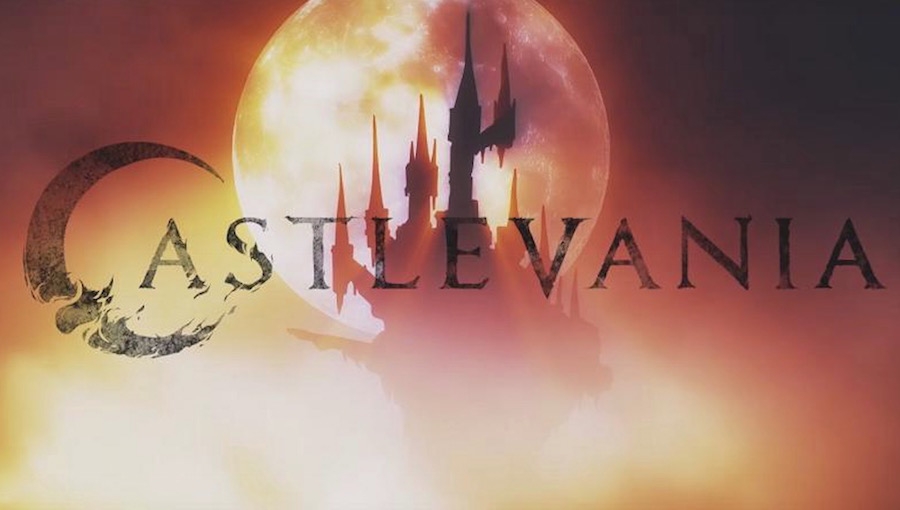Note: This panel coverage includes spoilers.
By 7 o’clock Thursday evening, July 20, 2017, Room 5 of the San Diego Convention Center was packed with eager fans, anxious to hear any scrap of information that Executive Producer Adi Shankar, Director Sam Deats, or Supervising Producer Brad Graeber might share at the “Netflix Original: Castlevania with Adi Shankar” panel moderated by Jessica Tseang (Little Geek Girl; Girl on Geek).
The animated Castlevania series premiered on Friday, July 7, and based on the vibe of the room, fans were ecstatic with the first season. Tseang stated she was aware that the biggest criticism of the first season was that it was too short, with just four episodes of approximately 23 minutes each – or a shorter feature length film. Graeber explained that the original Warren Ellis script (written back in 2007) was intended for a direct-to-DVD movie, but the market had gone flat – hence, the partnership with Netflix. Thankfully, fans of the franchise could rejoice: On the same day of the series premiere, Netflix announced that Castlevania had been picked up for a second season, with double the number of episodes!
Deats brought up that a lot of time and attention to detail went into pivotal moments. For example, he mentioned revealing Alucard as he rose up from his coffin, followed by the fight scene between Alucard and Trevor as a “love letter to fans of the franchise” and filled with direct and indirect details from the game. Graeber said that one of the other important scenes was Trevor’s encounter and subsequent fight with the Cyclops. Both scenes are breathtaking and filled with tension that snares and holds the viewer’s rapt attention. Shankar pointed to the “carnage scene” when Dracula lets loose his creatures of the night on the villagers and the church as having multiple layers of action. Graeber agreed, pointing out the specific sound effects that accompanied the woman turning around towards the camera, reveal that half of her face is gone.
Tseang turned the audience’s attention to the screen and showed the rough cut of the cyclops fight. The video revealed rough composition layouts in black-and-white line drawings prior to color, shading, etc. Fans enjoyed the clip and, of course, would have liked to have had more.

The panelists were asked to discuss how the characters were selected. Shankar stated that the creative team had built up a rapport that supported a debate-style format to hash out the various aspects of the show, but the characters were originally chosen by Ellis. Deats said that the characters’ stories tie together, starting with Lisa in the prelude of episode one. Graeber mentioned that the moment the statues return to their human existence after the cyclops was killed was the result of a debate amongst the team. Shankar stated that the season one is really about a sympathetic Dracula going too far: a “villain who was the hero of his own story.” But, he added that the series is about a family and its lineage. Deats said that he was happy to develop the Dracula character so he was not flat, but rather on par with the development of Trevor. Having grown up in Hong Kong where the anime had a more mature tone, Shankar related he was glad that Castlevania had embraced a more serious tone.
The adaption of the source material – video games – was excellent for this series, according to Tseang, to which there were many appreciative nods from the audience. Deats explained that was very important to everyone. It was crucial to present balanced stories and characters to support the narrative, especially since it was being adapted from an older video game (1989 if you go with the original publishing date in Japan). Graeber chimed in that Powerhouse Animation Studios (Austin, Texas) worked comfortably with video games to cinematic realizations – a fact that was not lost to fans in the room. (Excellent animation often associated with the studios in Japan, rightly so given their decades of experience.) So, how did an American studio get the job? Deats and Graeber said they were passionate about the project and that hunger fueled their effort. It paid off: They and Frederator Studios were selected to work on the series. Deats shared that the teams did not let up once they had the project; everyone was committed to it, putting in long hours to get it right.
At this point, there were only a few minutes left of the hour, so Tseang asked audience members with questions to line up at the center aisle microphone. Several people did. Questions included: (1) Is there a boss battle in Trevor’s future? (2) Will there be more nostalgic music? (3) Was there any scene the panel wanted to expand on? (4) Will Dracula’s castle figure more prominently in season two? and (5) Will the creative team include any of the other Castlevania games? All of these the panelists said they could not comment on these questions because they did not want to spoil the upcoming season; however, when asked about Konami’s involvement in the production and their reaction, Deats said Konami had a very positive response. They were helpful with pointing out small details to improve, as well as a few continuity errors, specifically during Alucard and Trevor’s fight in episode four. Graeger and Deats also added that they were very lucky to secure actor Richard Armitage (Thorin Oakenshield in The Hobbit). He came on board later than the other voice actors and recorded his dialogue in one long session. With that fact known, fans agreed with the panelists that Armitage is a true professional who breathed life and wit into Trevor Belmont.
Season one of Castlevania is currently available on Netflix, and season two is expected to release in 2018.

